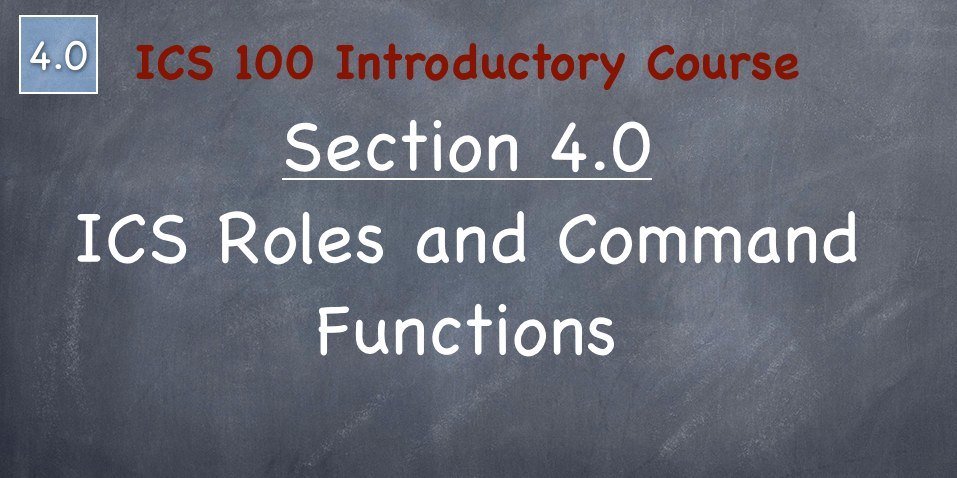DO NOT COPY - ALL contents - Copyright Protected
DRAM Ventures Inc. / www.firesafetraining.com

ICS 100 Introduction Course - Outline
1.0 Course Overview & Objectives
2.0 Introduction to the Incident Command (management) System
3.0 Main Components of ICS
4.0 IC Roles and Command Functions
5.0 General Section Staff Functions
6.0 ICS Facilities and Identification
7.0 Common Responsibilities
8.0 Short Quiz

DO NOT COPY - ALL contents - Copyright Protected
DRAM Ventures Inc. / www.firesafetraining.com
The above chart shows the "Command" structure above the black dotted line. There will always be an Incident Command.
The other Command Staff boxes or "functions" shown may not be present on smaller incidents or the early stages of what may become a large incident.
The chart also clearly shows the division in the ICS structure between Command and General Staff.
Note that the white connecting lines show the "chain of command" within the ICS
ICS is NO PLACE
for the
LONE WOLF OR SOLO individual.
Incident Commander
- every incident must have one
- establishes "command and control"
- begins assessing incident's needs
- ongoing assessment of IC structure needs
- responsible for all decisions and objectives
- accountable to appropriate jurisdiction supervisor
- responsible for all incident activities
- responsible for demobilization planning
- responsible for Incident Action Plan (I.A.P.)
- responsible for emergency medical plan
- responsible for responder evacuation plan
- must approve of all news releases and information given to public
Incident Commander - May change
- incident is downsizing
- incident is expanding beyond current I.C.s experience
- IC requires a rest period
- a different jurisdiction may take over incident responsibilities
When Changing Incident Commander
- must be communicated to all levels of IC
- must be communicated to all involved agencies and jurisdictions
- must have a briefing (Transfer of Command) (verbal or written) for incoming IC
Command Staff
( medium to larger incident)
- Safety Officer
- Liaison Officer
- Information Officer
- A Deputy I.C.
- A Unified Command
Note: On a smaller incident the I.C. assumes all of the above responsibilities.
Safety Officer
- provides IC information concerning all safety issues
- works closely with General Staff to ensure safety of all personnel
- ensures proper training, safety briefings and appropriate safety gear and devices are in place
- ensures proper safety structure are in place (ie. stairs; railings; seat belts )
- liaises with Operations Chief regarding Air-Operations safety
- reports to I.C. (or Deputy I.C. if so arranged)
Liaison Officer
- provides initial contact with other agencies involved in incident
- provides briefings for incoming supporting resources
- arranges for training of incoming supporting resources
Information Officer
- gathers relevant intelligence (information) from media, public, community leaders, other agencies and advises the IC
- prepares and delivers public media reports (IC must first approve)
- attends community meetings
- establishes good media relations
- establishes local agency and jurisdictional relations
- communicates directly with Planning Section for a two way dispersal of information
Deputy I.C.
(more common on a larger incident)
- take complete command and control to allow IC if IC is away or at rest
- may assist with specific agencies in a Unified Command
- may be given very specific tasks such as liaising with Command Staff
- considered as a second-in-command, assisting the IC wherever directed by the IC
- reports only to the IC
Unified Command
Under normal circumstances there is one person as the Incident Commander (I.C.) However, in a more complex incident, it is possible to have what is called a Unified Command.
Unified Command
This is when more than one agency is represented and are all in command. An example could be a major disaster to a community and members of the local police, fire, and medical services may all be in the Incident Commander Function - and they would be located physically at the Command Centre which is close to the scene of the incident. (safety considerations being priority)
Management by OBJECTIVES
All decisions are OBJECTIVE driven. Once OBJECTIVES are determined, these are COMMUNICATED TO THE PLANNING SECTION for dispersal to all levels of the IC System.
OBJECTIVES are based on three criteria:
1) Safety of life
- immediate rescue
- removal from incident to safety
2) Prevent Further losses (stabilize) Incident
- attempt to neutralize negative impact causes
3) Protect Property Values
plan for longer term protection and security
Objectives set may also be decided by previous jurisdictional directives.
Example: A Forest fire in a national park where park authorities have a Park Management Plan. It may be that natural caused fires will be allowed to burn - at least to certain geographical boundaries. Therefore the main objectives would be to protect and remove persons to safety but to let the other "resources" burn.
Demobilization
At the initial stages of any incident, it may be difficult to be considering "wrapping it all up" some time in the future. However, this is also an important consideration for the IC in the total decision and planning process.
Save lives - Rescue
Prevent Losses - Stabilize Incident
Protect Property
DO NOT COPY - ALL contents - Copyright Protected
DRAM Ventures Inc. / www.firesafetraining.com
DO NOT COPY - ALL contents - Copyright Protected
DRAM Ventures Inc. / www.firesafetraining.com
We wish to acknowledge and thank all organizations and persons for the use of all videos and photos on this web site.
